#Cinderella kemp co
Text
I NEVER liked the word 'Nice' either...

“Nice is a four letter word?”...... it's such an insipid word... so bland, dull and twee! I have always been insulted when called it myself. I get why he responded this way.... he's a demon.... can you imagine how insulted he felt... if I a mere human feels insulted by the word Nice!
I made this move once, not quite so violently though. I pushed Adam Ant against the wall when he was getting panicky before going onstage for his first/ opening night of the Joe Orton play of Funeral Games 1996. I totally understood why, because I got stagefright the night The Lindsay Kemp Company's Cinderella opened at Sadlers Wells the year before .I had toured Italy and Spain no stage fright... but London and knowing Adam and other friends were out there...arrghh! Adam suddenly lost the plot, and said he couldn't go onstage, and the easiest thing to do was hold him in place against a wall, and talk him down. It worked, after he had done the quick change after his first scene , he turned around and gave me a kiss, then saying Thank you. I guess both he and I would be accused of inappropriate behaviour these days... I liked my kiss from him... and he was happy to get onstage... can you imagine if he hadn't gone onstage...?
Good Omens always feels like it was in my head all along..... as it activates so many thoughts and memories....
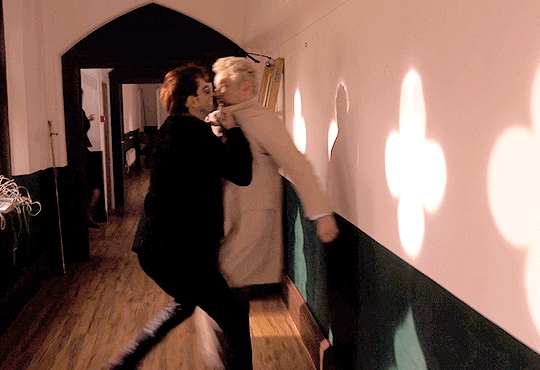
Makes me wonder what Good Omens 3 will trigger in my memory bank?
Funeral Games The Drill Hall, London 1996.
Not my programme, I never was one for collecting autographs in my career in Theatre.




I also got to work with Sylvester McCoy, my 2nd version of The Doctor...( the first was Colin Baker when he played Captain Hook.) 1989/90 at Brighton Dome.
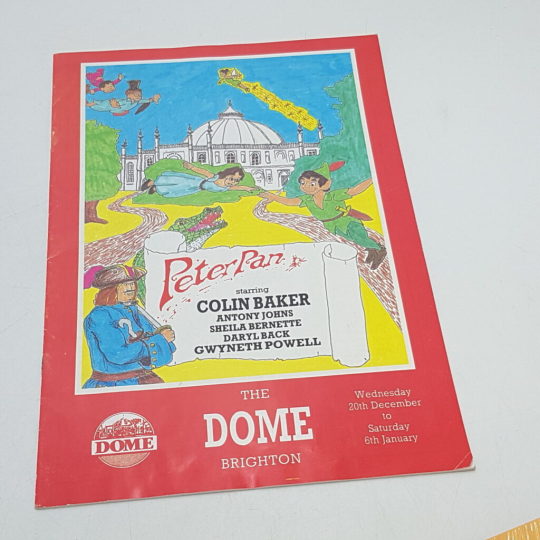

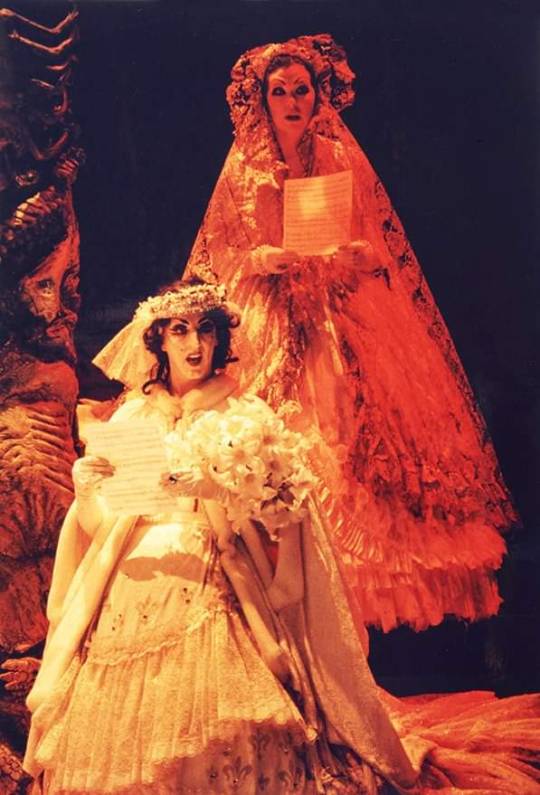
B/W...Me and Lindsay Kemp in Cinderella. Photo by Barbara Spegne. Italy. 1994
Colour photo ....Kinny Gardner and me, up my stairs. Sadlers Wells dress rehearsal. Photo Richard Haughton.
Everyone went onstage in the Kemp company, my main job was Associate Designer and Costume Supervisor.
Still can not believe I was part of the same theatrical company David Bowie was once part of... but Lindsay Kemp broadened his interests, as he did with anyone who became part of the company. Bowie often said Lindsay was the reason he started it all.
The Lindsay Kemp Company was a very gay/queer company. The majority of the performers were . A few of us were straight. The company was around before it was even legal to be gay in the UK... which it was from 1967. Many of the themes were about fluid genders. The show Flowers was based on Jean Genet's book Our Lady of the Flowers. JG was in and out of prison for being gay.
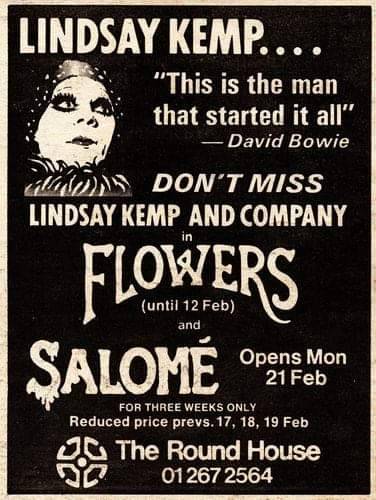
Happy World Theatre Day!
#crowleygoodomens#neil gaiman#demon crowley#good omens#good omens s2#anthony j crowley#good omens crowley#azriaphale#aziracrow#aziraphale x crowley#wall slam#aj crowley#adam ant#joe orton#funeral games#dr who#sylvester mccoy#thelindsaykempcompany#Cinderella kemp co#richard haughton#Barbara Spegne#colin baker#kinny gardner#lindsay kemp#david bowie#lgbtq#queer history#david tennant#michael sheen
20 notes
·
View notes
Text

Jobyna Ralston (born Jobyna Lancaster Raulston, November 21, 1899 – January 22, 1967) was an American stage and film actress. She had a featured role in the first Oscar-winning film, Wings in 1927, but is perhaps best remembered today for her on-screen chemistry with Harold Lloyd, with whom she appeared in seven movies.
Ralston was born in South Pittsburg, Tennessee, on November 21, 1899 to Joseph Lancaster Raulston and Sarah E. Kemp Raulston. She was named after famed entertainer of the time, Jobyna Howland. She had a younger brother, Edward Angus (born 1905). Ralston's mother, a portrait photographer, carefully groomed her daughter for a show business career.
At the age of nine she gave her first stage performance as Cinderella during the grand opening of the Wilson theatre/Opera House in 1909. Around 1915, Ralston attended acting school in New York. She later danced chorus and sang in Broadway productions, her first being Two Little Girls in Blue. This production marked her Broadway debut, when she was 21. Comedian Max Linder saw her on stage and persuaded her to go to Hollywood, where she appeared in a number of his films. She also co-starred in Humor Risk (1921), the fabled lost comedy short film that was to be the film debut of the Marx Brothers. Soon director Hal Roach began to star the actress in one-reel comedies. She abandoned the stage for the screen in 1922 when her mother's health began to decline, and she needed to make more money to help pay the medical bills.
In 1923, she was named by the film industry as one of the WAMPAS Baby Stars. This award was given every year to the top up and coming female stars. This same year she starred with silent comedian Harold Lloyd in Why Worry?, and for the next five years appeared in six of Lloyd's feature films as his leading lady. It is for these performances and her onscreen chemistry with Lloyd that she is best remembered today. She would start the trend for romantic comedies with Girl Shy (1924).
As a freelance actress, Ralston co-starred with Richard Arlen, in the first Oscar-winning film, Wings (1927). She had a feature role in the film, which also featured Clara Bow, Gary Cooper, and Buddy Rogers. She would star in eleven more motion pictures, among them Special Delivery (1927) co-starring Eddie Cantor. Her film career ended after two early talkies when she became a mother. Her last talkie, Rough Waters (1930), found her acting with Rin Tin Tin.
Ralston was married twice, the first time to childhood beau John Campbell, the second in 1927 to actor Richard Arlen, whom she had met on the set of Wings. They had one child, actor Richard Arlen Jr. The family appears together in Hollywood on Parade # A-4. Ralston and Arlen divorced in late 1946.
During the last five years of her life Ralston suffered from rheumatism and had a series of strokes. She died in 1967 from pneumonia at the Motion Picture Country Home in Woodland Hills, Los Angeles, California. She was 67 years old.
47 notes
·
View notes
Photo

Touching the Void.
Searching for cinema that soothes? Ella Kemp suggests it could be as simple as looking for a film poster with a white background.
How many weeks has it been? When did any of us last go blindly into a cinema and take a chance on something new? Film-watching in the time of Covid-19 has changed. The immediate and never-ending news of the world is frightening. Is it still, and more than ever, okay for me to sink into movies to alleviate my mood, just for a bit? How is that even possible when the world has come to a standstill?
We are forced to adapt, and it has taken some time for my attention span and emotional capacity to adjust. But I think I might have found a solution, and I have the meticulous list-makers of Letterboxd to thank. It was Izzy’s list of comfort movies that first lit the fuse. Specifically, the second, third and fourth row; films including Billy Elliot, Clueless, School of Rock.
Fifteen stark posters, speaking one truth: We are vulnerable and nervous. What we need is a film poster with a white background to assure us the movie exists entirely to serve and soothe us.

Part of Izzy’s ‘comfort movies’ list.
List-making on Letterboxd has never been more prolific. Pandemic movies, overdue filmography catch-ups, comfort movies galore. Everyone categorizes and logs their watches differently, but Izzy’s pattern speaks to me with an epiphanic answer. I’ve always admired successful color-coding, but now I see its crucial function.
As I scroll for distraction, for something guaranteed to be good (because I cannot and will not be subject to any uncertainty I can avoid), I see the rainbow. The pale blues of Studio Ghibli, Wong Kar-wai’s passionate reds, the pastels of Netflix Original breezy romances. Like some kind of cinematic ikebana, countless Letterboxd members have mastered the art of arranging film posters. There are standouts: the staggering oeuvre that is Gordon’s chromatic roundup of favorite posters; the comprehensive color-graded history of women directors via their best posters, courtesy of Vanessa; and the penchant for beige in the year 2015, as spotted by Letterboxd co-founder Matthew Buchanan.
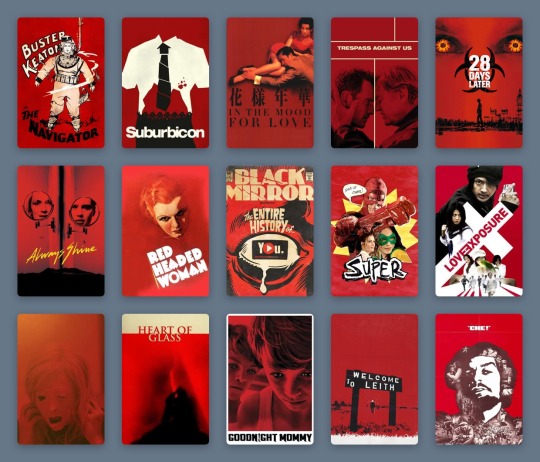
A selection of Gordon’s favorite movie posters.
But when I see these 300 examples, color-coded by typography and accents by Sera Ash, I recognize that white movie posters are the ones most likely, in this very strange time, to take care of me. I see it in three distinct filmmaking periods: Disney animations from the 1940s and 50s, the video marketing for cult comedies of the 1980s and 90s, and the alternative marketing materials of my favorite films of the 2010s. Each poster is straightforward and inoffensive. It captures the story, but never dares to impress or intimidate beyond basic description.
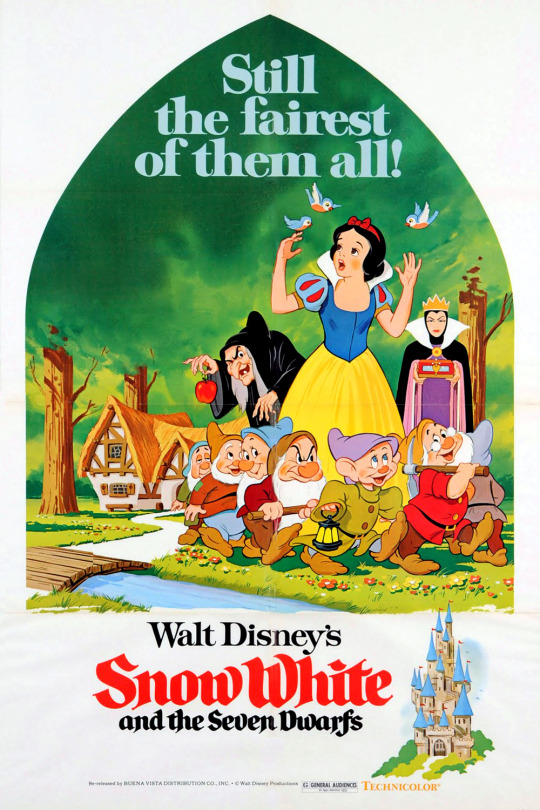
A 1975 re-release poster for ‘Snow White and the Seven Dwarfs’ (1937).
In 1937, Snow White and the Seven Dwarfs announced the birth of Walt Disney’s feature-length empire. While its original theatrical poster is also mostly white, it is represented on Letterboxd by a 1975 re-release poster depicting a peek through the keyhole: a curved triangle framing Snow White, the dwarves, and the two sides of the jealous queen, against a vivid green forest. In the bottom corner, a castle. To the left, the title—her name in red cursive, theirs in black. These simple images come together to present an elementary summary of the ingredients within. The white frame showcases the seminal animation craft without suggesting the viewer diverts their eye anywhere else.
This technique was common across other animated titles, collected in lists like dantebk’s Disney animated classics. Pinocchio toys with the hyperreal relationships between characters alive and wooden, human and animal—but does so on a plain canvas, so that the magic remains within reach. Dumbo, Bambi, Cinderella, Peter Pan—each follows suit. Whether with the mustard yellow of a circus tent, the faint sketches of grass tufts, the gold dust of an enchanted fairy godmother or the ink blue of a midnight starry sky, these colors (indicative of each defining scene-setter or mood-maker) only pepper a blank background, and so make their significance ever greater with the most sporadic touches.

A selection from dantebk’s list of Disney animated classics.
Live-action knockouts from these decades—films like The Shop Around The Corner and The Red Shoes—embrace painted recreations of their protagonists (Margaret Sullivan and James Stewart as festive lovers in the former, Moira Shearer as a tortured ballerina in the latter) and use the color red as a signifier of romance, against a plain white page, to set the mood. Slashes and splashes of red have been used to create a vibe in genre cinema for many decades—a trend deftly chronicled in this list by Rocks.
As far as we know, the underpinnings of digital photography began in the 1950s, and the first published color digital photograph dates back to 1972, when Michael Francis Tompsett shot a photo of his wife Margaret for the cover of Electronics magazine. Consumers got their hands on the gear in the late 1990s, but movie studios really started to make the most of sharp digital photography and stark white backgrounds for their striking posters from the late 1980s onwards. Because, never mind the multiplex, the video store is where you wanted your comfort fare to stand out in the 1980s and 90s.
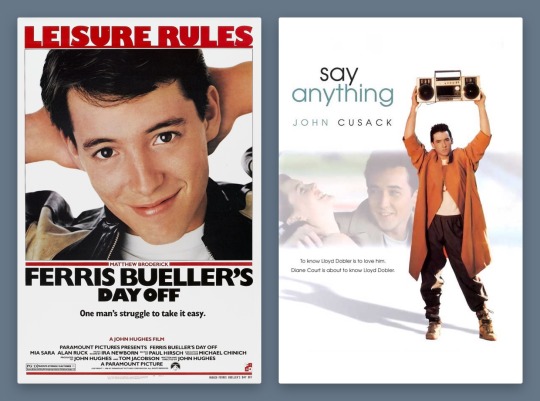
Ferris Bueller’s Day Off (1986) and Say Anything… (1989) form a handsome, trend-setting 1980s pair. While the theatrical poster for Cameron Crowe’s Say Anything… deigned to include John Cusack’s co-star, Ione Skye, by the time of the film’s video release, the focus is clearly on pre-High Fidelity Cusack, as proud underachiever Lloyd Dobler, smouldering lopsidedly under the weight of a boombox. It’s the singular image of the film to this day.
Meanwhile, Matthew Broderick as Ferris-slacking-Bueller is making the most of his title activity, arms behind his head, a proud smirk on his face. Nothing else matters except that these charismatic young stars are stepping up to leading-man status. The white background accentuates the star power of these new boys in town, embracing the limelight in one fell swoop.
Star power is everything: beautiful people doing simple things against empty backdrops, because what could be more important than the regularity of symmetrical bone structure, of familiar charm? The trend boomed in the 1990s and 2000s, in films widely embraced by casual moviegoers. The sort who list “watching Netflix” as a Sunday activity on dating profiles and use the Christmas holidays to rewatch comedies they have memorized over dozens of half-attentive viewings (absolutely zero judgement here!).
The vast majority of these films have white posters. Who is your soothing cup of charm: Tom Hanks on a bench, nothing more nothing less, from 1994’s Forrest Gump? Or Heath Ledger, effortlessly cool, leaning on the brown corduroy armchair Julia Stiles sits in for the 10 Things I Hate About You poster from 1999? (The 90s harnessed the increased appeal of having two lookers just sitting and posing against a plain background, as demonstrated in this chilling list by Ashley.)
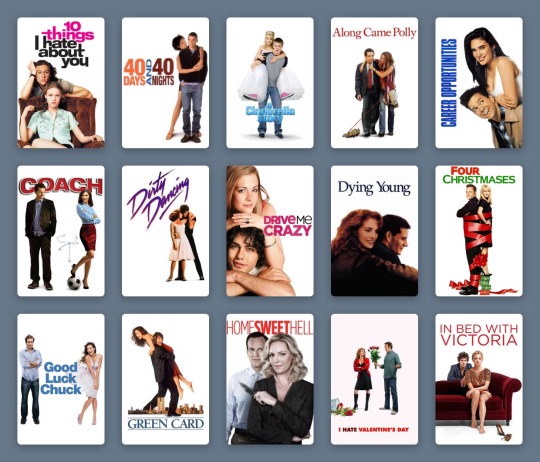
Ashley’s list of couples posing in front of a white background.
Will Ferrell had been earning his stripes as an actor for years, but he changed the movie comedy game as Buddy the Elf in 2003. There’s plenty of visual humour in Elf, but Ferrell’s coat-stand posture bedecked in festive green velvet and those tights is… enough. A white background lets the ridicule slide, just.
How many Disney series really deserve a whole movie—and one that stands the test of time? Lizzie McGuire, resting on her tiptoes with a swinging suitcase in hand, sells The Lizzie McGuire Movie like no idyllic views of Rome ever could. It’s reaching out to an audience loyal to the character, one who will follow her to the ends of the Earth, or at least to another continent. Hilary Duff could be doing almost anything on this poster and it would achieve the same effect—so long as the white background remains plain enough to keep eagle-eyed fans on the main event at all times.
It’s surprising that the star-making system only let Meryl Streep appear in a tiny box, one of four character tiles, on the poster for The Devil Wears Prada in 2006. But the design here taps into 1940s animated sensibilities, giving prominence to a devilish red Macguffin larger than the humans. It still achieves the same function—a glossy, glamorous design with the accessible sell of a quotable, star-fuelled comedy.
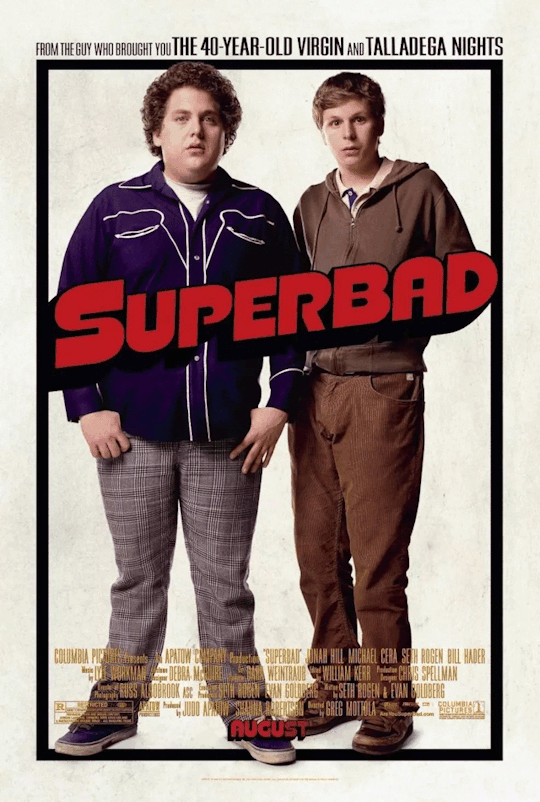
Red may be the color of romance and the devil; it’s also the color of comedy. Exhibit A: the 2007 gross-out comedy Superbad, whose star power—marking the emergence of Jonah Hill and Michael Cera—is used to an opposite and impressive effect on its poster. The awkwardness of these teen boys—lanky, unkempt, insecure—is what cinches the comedy. The simplicity of the poster design, with their uncomfortable posture against, well, nothing at all, further anchors their incapability of facing the world in any confident way, shape or form.
There are countless more examples, like Marley & Me, Bridesmaids, 27 Dresses (notice how the red type is replaced by pink when the film’s plot veers toward the altar). But to understand the curious and timeless appeal of the white movie poster, what happened to it in the 2010s cements its adaptable strength.
As the art of graphic design has continued to bloom, the aesthetic argument for the colorless color-block movie poster has shifted to embrace a film’s context. Consider Danny Boyle’s Steve Jobs, the enjoyable 2015 drama that provided Michael Fassbender one of the most under-celebrated roles of his career, playing the late Apple co-founder. The poster turns the canvas into a blank screen: the title is typed, the text insertion point poised, waiting for the next key press. As Jobs, Fassbender occupies the bottom right corner, in profile, thinking.
This starkness makes sense: what’s next, Steve? It offers a rare example of a poster from the past decade that fully leans into the monochrome aesthetic entirely on purpose—to serve the restrained and unequivocal need for white. (And it’s interesting to compare with the marketing narrative for an earlier film about another tech leader: observe how Jesse Eisenberg’s Mark Zuckerberg eyeballs us from The Social Network’s dark-mode poster.)

Comfort movies don’t own the white poster, of course. Jordan Peele’s Get Out toys, both in its marketing and its delivery, with the binaries of black and white. It’s deployed on-screen with sophisticated horror, and this extends to its two most graphic poster variants.
While one poster sees Daniel Kaluuya’s character, Chris, sat on a chair split vertically between black and white, the all-white poster allows only a center-frame letterbox to reveal Chris’s enormous eyes, accompanied by an all-caps type treatment. The vast expanse of white only makes the image more menacing, framing the claustrophobia so effectively. The landscape crop is a device that defines stern dramas as much as arthouse comedies, as documented by Haji Abdul Karim in their expansive list.
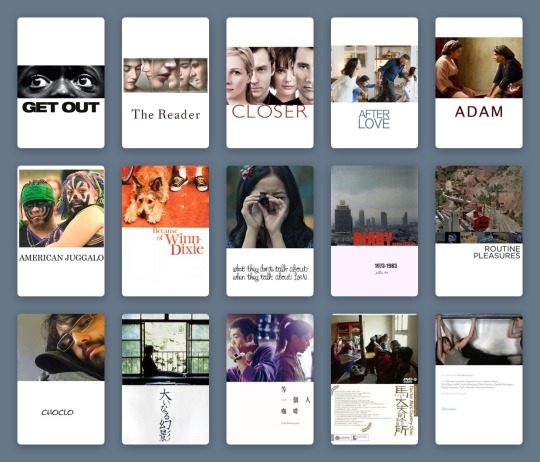
Haji Abdul Karim’s list of white-with-landscape-image posters.
But back in the ‘comfort’ realm, we’re seeing more and more that the marketing wants to have it both ways—the negative with the positive; the art house audience and the multiplex crowd. As genres blend, demographics collapse and audiences become more fluid, a film’s advertising needs to speak more languages.
Two ultra-comfort films from last year demonstrate this idea well. The poster for Judy sees a backlit Renée Zellweger finding her light, receiving her applause. Black is the key color, right down to the classic little black dress; the eye is drawn to the title, spelled out in red sequins. It’s showbiz, it’s drama. Though the film itself fudges a few of the more uncomfortable facts of the star’s story, it’s still honest about her addictions.
In the white-background version, which was more widely distributed, Zellweger, in a floral dress, turns away from the light. The name still sparkles, but in softened gold. There’s no less glamor, the stakes in the film are just as high, but she’s perhaps more accessible like this. The focus, as it was in the 90s, 80s, 40s, returns to the main event.
Greta Gerwig’s Little Women, too, played with dark and light. The indie queen released her previous film, Lady Bird, via design-conscious distributor A24, and Gerwig’s singular aesthetics promised that her Little Women remake would be worlds away from all the others. But when the first images for the film were released, the marketing campaign was questioned by die-hard Gerwig fans.

Both of the group posters are curiously stripped back, freezing Louisa May Alcott’s beloved March sisters in a moment. In the darker image, they gaze out a window, secure in their festive domestic bubble, but set on what’s beyond. There’s more to life, and the film, than this room. It feels more lush, painterly, certainly more dramatic.
Whereas the white poster, at first, seemed like a mistake. It took one of the first images teased from the film and just... dropped it onto a poster. The March sisters look as if solidified by clay, entirely undynamic and at odds with the fluidity and warm soul Gerwig had made herself known for in her filmmaking.
And yet, nothing matters more than these characters. Beth, Jo, Meg and Amy are holding each other, happy, each in their own favourite color, and there is nothing more to fight over. The white-poster alternative lets the 2010s viewer stay attached to the most important part of the film.
The lessons here? A white poster is a vital sign that you’re safe here. You’ve made the correct choice. Attention spans are dwindling, options are expanding, focus is difficult. The promise of a white frame tells me what matters, what is good, where I should place my time and my value. For now.
#movie poster art#poster design#film poster#film poster design#movie marketing#movie design#white posters#comfort movies#comfort films#letterboxd lists#Letterboxd#little women#judy#ferris bueller#disney#graphic design
12 notes
·
View notes
Text
Plymouth's Theatre Royal is now a listed building
New Post has been published on http://harryandmeghan.xyz/plymouths-theatre-royal-is-now-a-listed-building/
Plymouth's Theatre Royal is now a listed building
The Theatre Royal holds a special place in the hearts of Plymouth people.
Now the Royal Parade attraction can be enjoyed for generations to come after heritage experts granted it special protection.
The 36-year-old cultural mecca has been Grade II-listed – one of a number of new UK sites safeguarded by Historic England.
Cultural chiefs who signed off the deal praised the venue – opened by Princess Margaret in 1982 – for its ‘sophisticated example’ of 20th century design.
They also lavished praise on the Theatre Royal – commissioned by Plymouth City Council as a venue that could cater both large and small productions – for its ‘distinctive geometric forms’.
The milestone comes as theatre bosses bring to life one of the biggest public artworks to land in Plymouth for some time.
A giant bronze sculpture dubbed ‘Bianca’ (though that is not her official name) will stand proudly outside the Theatre Royal potentially by the end of the year, as reported by Plymouth Live.
Bianca: The key facts
Planning permission for installation of the bronze sculpture was granted by Plymouth City Council on February 9, 2017.
The sculpture is based on a pose struck by the actress playing Bianca in Frantic Assembly’s version of Othello, which was co-produced with the Theatre Royal Plymouth.
Weighing around 3,500kg, the sculpture will measure seven metres tall and nine metres (30ft) wide. To put that into perspective, the average double-decker bus measures 4.38metres tall by 15 metres wide.
The idea for a sculpture was born three years ago and forms part of the Theatre Royal Plymouth’s £7.5million regeneration project.
The artist behind the sculpture is Joseph Hillier, born and raised in Helston, Cornwall, and who studied at Falmouth College of Art before attending Newcastle University.
Frantic Assembly is an award-winning company creating “thrilling, energetic and unforgettable theatre with a unique and physical style”. The company has co-produced seven shows with Theatre Royal Plymouth including Lovesong, The Believers and Othello.
Standing seven-metres (23ft) tall, nine-metres (30ft) wide and weighing in at more than eight tonnes, the sculpture will be a third of the height of Smeaton’s Tower, wider than a tennis court and heavier than an African bull elephant.
It brings the number of buildings and sites under protected status in England to 400,000.
Historic England chief executive Duncan Wilson said: “The list is a treasure trove of special historic places that demonstrates the rich variety of England’s history.
“Reaching 400,000 entries is a milestone – it confirms just how important our heritage is and how much deserves protecting for future generations.”
Construction of Theatre Royal car park, 1980
Culture Secretary Jeremy Wright said: “The National Heritage List for England tells the story of our past, and the people, places and events that shaped it.
“This landmark highlights the huge diversity of historic places that we have protected and the integral role heritage plays in our culture.”
Other national sites adopted by Historic England include the Art Deco terminal at Birmingham Airport and a 200-year-old cottage in Shropshire – which once housed animals and their owner under one roof.
Plymouth’s culture boss, Councillor Peter Smith said: “The Theatre Royal was built as somewhere where arts could thrive and a place for the people of Plymouth as well as the surrounding towns and countryside to enjoy quality performance and entertainment.
“It has become a key part of the city’s night time economy – to put it simply – a great night out for all ages, it has become a cultural powerhouse for the region and we are very proud in our role in making this happen.
“Getting the design right and flexible enough to take the big productions as well as allow experimental and smaller theatre to grow has proved to be so important.”
Theatre Royal: Key facts
It consists of a 1,300-seat main auditorium, The Lyric, which regularly hosts large-scale musicals, opera and ballet; a 200-seat studio, The Drum; and a 50-seat studio, The Lab.
On a separate site, Theatre Royal Plymouth also has a production and learning centre, TR2, featuring rehearsal studios and workshops for the production of set and costumes.
The theatre is a National Portfolio Organisation, receiving regular funding from Arts Council England.
A £7million regeneration Project was completed in September 2013 with a renovated front of house area and community performance space called The Lab.
Time Line
Theatre Royal: A Plymouth success story
1982
HRH Princess Margaret opens the Theatre Royal. Royal Charity Gala held with Leonard Rossiter, Dickie Henderson & Gene Pitney performing
Jazz legend Ella Fitzgerald performs
1983
Eric Sykes performs alongside Matthew Kelly in Alan Ayckbourn’s Time and Time Again
Warren Mitchell performs as Alf Garnett in The Thoughts Of Chairman Alf
The Three Degrees & Eartha Kitt perform
Terry Scott performs in Babes in the Wood
1984
Andrew Lloyd Webber’s Song & Dance performed at the Theatre Royal. This is the first Cameron Mackintosh production to come to the Theatre Royal. Stars Wayne Sleep & Marti Webb
Roger Redfarn appointed as Artistic Director
Danny la Rue appears in Mother Goose
1985
Lauren Bacall stars in Tennessee Williams’ Sweet Bird of Youth
1986
Michael Bogdanov and Michael Pennington found the English Shakespeare Company, the inaugral production premieres here. The company go on to tour across the UK and worldwide
1989
Buddy co-produced with Paul Elliott premieres at the Theatre Royal
1990
Adrian Vinken OBE appointed General Manager
Des O’Connor stars in Cinderella as Buttons
1991
Barbara Windsor stars in Guys & Dolls
High Heels in the Rubble, about the Plymouth Blitz and performed by the people of Plymouth, opened with a guest appearance from Dame Vera Lynn
Sir Ian McKellen appears in Richard III
1992
Theatre Royal takes over operation of Plymouth Pavilions
Les Dawson stars in Dick Whittington
Edward Woodward appears in A Dead Secret
1993
Act Now campaign – Arts Council funding cut threat. Over 57,000 letters of support for the theatre stuck to the theatre’s windows, convoy of 20 coaches taken from Plymouth to Arts Council Head Office where opponents of the cuts sing a song from Les Miserables and hold a torchlight procession. Campaign was a success
Brian Blessed performs his one-man show
Bill Nighy appears in Arcadia
1994
World premiere of Copacabana with Barry Manilow in attendance. Gary Wilmot plays the lead role
Adam Faith performs in Alfie
1995
Out of the Rubble performed with over 500 people from the local community to commemorate the 50th Anniversary of VE Day
World premiere of Jolson starring Brian Conley
1996
Theatre Royal’s Young Company and People’s Company formed
Matthew Bourne’s Swan Lake performed. The first of many Matthew Bourne productions to be performed at the Theatre Royal
1997
Cameron Mackintosh’s Les Miserables tour opens at the Theatre Royal
First year of a 3 year residency for the Royal Shakespeare Company in the South West – Shakespeare performed in the Theatre Royal, Drum and Pavilions
Russ Abbot starred as Captain Hook in Peter Pan
1998
Cameron Mackintosh’s The Phantom of the Opera starts its UK tour at the Theatre Royal
Simon Stokes joins the Theatre Royal as Artistic Director
1999
Jason Donovan stars in The Rocky Horror Show as Frank ‘n’ Furter
2000
TMA voted the Theatre Royal Plymouth the Most Welcoming Theatre
Simon Callow stars in The Mystery of Charles Dickens
Hundreds of local people involved in Union Street, a story about Plymouth’s most famous street created with local volunteer researchers, performers and backstage teams with the help of a professional creative team
2002
Richard Briers performs in The Tempest
The Green Man performed in the Drum Theatre with Phil Daniels and Danny Webb
2003
TR2 opens – Europe’s first purpose built production and education centre opened by the Earl of Wessex on his own, contrary to the plaque in reception!
Cameron Mackintosh’s UK tour of Cats begins life at TR2 with the workshops undertaking their first major set build while the company are the first to use rehearsal rooms
Theatre Royal’s 21st birthday
Ross Kemp appears in The Taming of the Shrew
2004
Launch of the new touring production of Miss Saigon
Refurbishment of Theatre Royal auditorium – yellow seating replaced with blue seating
Theatre Royal voted whatsonstage.com Best Regional Theatre
2005
Philip Ridley’s controversial play Mercury Fur, a Drum co-production with Paines Plough, opens starring Ben Wishaw
The History Boys with James Corden and Dominic Cooper in the cast
World premiere of Matthew Bourne’s Edward Scissorhands
2006
The controversial Jerry Springer – The Opera tour opens at the Theatre Royal
Yukio Ninagawa’s Titus Andronicus performed in Japanese on the Theatre Royal stage
First UK performance of White Christmas on the Theatre Royal stage with Ken Kercheval and Lorna Luft starring alongside Craig McLachlan
2007
Drum Theatre wins The Empty Space Peter Brooke Award
2008
World premieres of the international tour of Cameron Mackintosh’s Mary Poppins, Flashdance the Musical and Matthew Bourne’s Dorian Gray
Frantic Assembly present Othello, a co-production with the Theatre Royal and their first production to be performed on the Theatre Royal stage
Lesley Garrett appears in Carousel
2009
Major new touring version of Pete Townshend’s rock opera Quadrophenia opens
Alistair McGowan stars in Measure for Measure
2010
Alison Steadman stars in Alan Bennett’s Enjoy
World premiere of Lend Me A Tenor, a Theatre Royal co-production which goes on to play in the West End
Complicite’s A Disappearing Number broadcast live across the world from the Theatre Royal
2011
Lovesong, a co-production with Frantic Assembly, premieres in the Drum and stars Sian Phillips
Complicite opens The Master and Margarita
2012
Cameron Mackintosh tour of The Phantom of the Opera opens at the Theatre Royal
The Drum Theatre presents its own productions, The Astronaut’s Chair and Horse Piss For Blood
Mathew Bourne’s Sleeping Beauty has it’s world premiere on the Theatre Royal Stage
The Theatre Royal Plymouth is awarded the funding for it’s Regeneration Project
2013
Theatre Royal Plymouth productions of Forever House by Glenn Waldron and Solid Air by Doug Lucie open in The Drum
Theatre Royal Plymouth co-production with Told by an Idiot and Young Vic My Perfect Mind
Fight Night; a co-production with Belgian theatre company Ontroerend Goed
2014
Theatre Royal Plymouth productions of MAD MAN, Grand Guignol, Another Placeopen in The Drum
Co-productions include The Believers, SmallWaR, The Angry Brigade and Sirens
2015
Merit, After Electra, and The Whipping Man are Theatre Royal Plymouth productions
The Solid Life of Sugar Water, a co-production with Graeae Theatre opens in The Drum, followed by a successful Edinburgh Fringe Festival run and UK tour, ending at the National Theatre.
Pardon/In Cuffs written by Valentijn Dhaenens previews in The Drum before it’s Edinburgh Fringe Festival run at the Traverse Theatre
2016
The Theatre Royal Plymouth production of James Graham’s Monster Raving Looney opens in The Drum. Followed by a 5-week run in London at Soho Theatre
The Man With The Hammer written by Phil Porter and produced by Theatre Royal Plymouth
Russian playwright Mikhail Durnenkov’s play the war has not yet started produced by Theatre Royal Plymouth opens in The Drum
Shon Dale Jones’s The Duke is co-produced with Hoipolloi, PBJ Management and Theatre Royal Plymouth
Told by an Idiot return to The Drum with Heads Will Roll a co-production with Told by an Idiot
Ontroerend Goed return with World Without Us a co-production with Arts Centre Vooruit Ghent, Theatre Royal Plymouth & Richard Jordan Productions, previews in July and embarks on a hugely successful Edinburgh Fringe Festival run. Winning a Fringe First award before returning to The Drum in November.
Billy Elliot The Musical starts its UK & Ireland tour in Plymouth
BIG The Musical starring Jay McGuiness makes its European Premiere
Disney and Cameron Mackintosh’s Mary Poppins enjoys a magical run at Theatre Royal Plymouth
Wind in the Willows starring Rufus Hound opens in The Lyric and has now been confirmed for a London Palladium run in 2017
Want more news?
To keep up to date with Plymouth Live’s latest news, follow us on Facebook here and Twitter here, or visit our homepage at www.plymouthlive.com
For Devon news, find Devon Live’s Facebook page here, or their Twitter page here, or visit their homepage at www.devonlive.com
For Cornwall news, find Cornwall Live’s Facebook page here, or their Twitter page here, or visit their homepage at www.cornwalllive.com
Do you have a story to share or for us to investigate?
Get in touch using [email protected], call 01752 293 066 or tweet me @ph_milesoleary
0 notes
Link
THE RED SHOES. Ashley Shaw ‘Victoria Page’. Photo by Johan Persson
New Adventures are delighted to announce North American tour dates and casting for Matthew Bourne’s double OLIVIER AWARD winning production of THE RED SHOES. The production will make its American debut as part of a World Premiere tour, starting at the Ahmanson Theatre, Los Angeles on Friday 15 September 2017; and continuing to the Kennedy Center, Washington DC; Blumenthal Performing Arts, Charlotte and New York City Center. Full tour dates are below. http://ift.tt/1pclkBm.
The World Premiere tour of THE RED SHOES opened at the Theatre Royal Plymouth in November 2016 ahead of a sold-out eight-week Christmas season at Sadler’s Wells, where it opened to rave reviews. The performances at Sadler’s Wells were the fastest selling in New Adventures history. There are just two venues left on the UK tour. Due to popular demand, following sold out dates earlier this year the show is returning to The Lowry, Salford (11 July – 15 July) and Birmingham Hippodrome (18 July – 22 July).
The original award-winning cast returns to recreate their critically acclaimed performances in these iconic roles.
The role of “Victoria Page”, the girl who dreams of being a great dancer, immortalised on screen by Moira Shearer, was created by New Adventures leading lady, Ashley Shaw, in a career defining performance. New Adventures rising star, Cordelia Braithwaite, who has also received great praise for her interpretation will return for the USA Tour. For the run at New York City Center only, New York City Ballet star, Sara Mearns, will also play the role of “Victoria Page” making her New Adventures debut.
Sam Archer who created the title role of Edward Scissorhands in 2005 and who has starred in Cinderella, The Car Man and Play Without Words returned to the company to create the iconic role of Svengali-like Impresario “Boris Lermontov” Having recently made his debut in the role, Jack Jones will also play Lermontov at some performances.
The role of “Julian Craster”, was created by one of New Adventures most popular dancers, Dominic North, who was last year nominated for his second National Dance Award. Joining him, we are delighted to welcome back American Ballet Theatre star, Marcelo Gomes, who will be making his debut as Julian at all venues during the USA Tour. Marcelo was last seen with New Adventures in The Car Man at Sadler’s Wells in 2015 having previously danced “The Swan” in Matthew Bourne’s Swan Lake in Tokyo in 2014.
Completing the principal cast are the leading dancers of the Lermentov Company. Prima Ballerina, “Irina Boronskaja” is played by Michela Meazza, who returns to New Adventures where she has danced and created many leading roles (Los Angeles and New York only). She is joined by Company favourites Anjali Mehra, most recently seen as both “The Queen” and “The Girlfriend” in Swan Lake and Nicole Kabera, who most recently played “Queen Eleanor” in Sleeping Beauty.
“Ivan Boleslawsky” the role made famous by Robert Helpmann has been created by one of New Adventures finest young dancers, Liam Mower (the original West End Billy Elliot but now taking on his seventh principal role with New Adventures). Also playing Ivan is popular company dancer, Danny Reubens, who scored a great personal success recently as “Jack” in Lord Of The Flies and rising star, Will Bozier.
Lermontov Company choreographer and ‘character dancer’ “Grischa Ljubov”, has been created by veteran company dancer, Glenn Graham, who as well as playing “The Swan” in Swan Lake has recently been seen as “King Benedict” in Sleeping Beauty. Also playing the role of “Grischa” will be Leon Moran recently seen in Sleeping Beauty, The Car Man and as “Jim” in Edward Scissorhands.
THE RED SHOES. Sam Archer ‘Boris Lermontov’ and The Company. Photo by Johan Persson
Completing the New Adventures cast as the leading dancers and creative team behind the Ballet Lermentov are Steph Billers (cover “Irina Boronskaia”), Jackson Fisch, Joshua Harriette, Daisy May Kemp, Phil King (cover “Julian Craster”), Dominic Lamb (cover “Grischa Ljubov”), Katrina Lyndon (who also plays “Victoria Page”) Kate Lyons, Andrew Monaghan (who also plays “Julian Craster”) Joe Walkling, Katie Webb (cover “Victoria Page”) and Seren Williams.
Long time company dancer Chris Trenfield, who co-created the roles of “Julian Craster” and “Boris Lermontov” will be retiring from New Adventures at the end of the UK Tour. His final performance will be at the matinee at The Birmingham Hippodrome on Saturday 22nd July.
A beloved fairy-tale and Academy Award-winning movie, THE RED SHOES has seduced audiences and inspired generations of dancers with its tale of obsession, possession and one girl’s dream to be the greatest dancer in the world. Victoria Page lives to dance but her ambitions become a battleground between the two men who inspire her passion.
Matthew Bourne’s magical new adaptation of the legendary Powell and Pressburger film reunites him with his regular collaborators and New Adventures Associate Artists and the team that brought you the world wide hit, Sleeping Beauty; Lez Brotherston (set and costumes), Paule Constable (lighting) and Paul Groothuis (sound).
This World Premiere is set to a new score arranged by New Adventures Associate Artist, Terry Davies using the mesmerizing music of golden-age Hollywood composer, Bernard Herrmann (most famous for his collaborations with Alfred Hitchcock, Orson Welles and Martin Scorsese), whose work ranges from the witty and playfully robust to the achingly romantic and bittersweet.
An intoxicating drama where life imitates art with fateful consequences; THE RED SHOES will dazzle your senses and break your heart.
THE RED SHOES is supported using public funds by Arts Council England.
The North American tour dates will be supported across the continent with a program of workshops; curtain raisers and masterclasses for young people and emerging artists led by Re:Bourne, the charitable arm of New Adventures.
US TOUR DATES 2017
FRIDAY 15 SEPTEMBER – SUNDAY 1 OCTOBER
AHMANSON THEATRE, LOS ANGELES, CA http://ift.tt/16wg9Nu
PRESS NIGHT – TUESDAY 19 SEPTEMBER
TUESDAY 10 OCTOBER – SUNDAY 15 OCTOBER
THE KENNEDY CENTER, WASHINGTON, DC http://ift.tt/uW7xzj
PRESS NIGHT – TUESDAY 10 OCTOBER
TUESDAY 17 OCTOBER – SUNDAY 22 OCTOBER
BLUMENTHAL PERFORMING ARTS, CHARLOTTE, NC http://ift.tt/1jiyuZI
PRESS NIGHT – TUESDAY 17 OCTOBER
THURSDAY 26 OCTOBER – SUNDAY 5 NOVEMBER
NEW YORK CITY CENTER, NY www.nycitycenter.org
PRESS NIGHT – THURSDAY 26 OCTOBER
http://ift.tt/2t6pD4O LondonTheatre1.com
0 notes